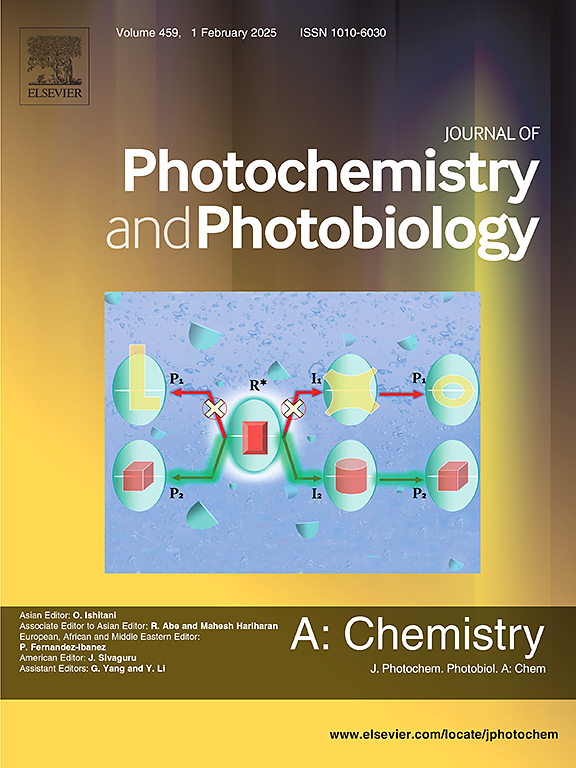不对称蒽衍生物作为高性能oled的电子传输材料
IF 4.7
3区 化学
Q2 CHEMISTRY, PHYSICAL
Journal of Photochemistry and Photobiology A-chemistry
Pub Date : 2025-06-02
DOI:10.1016/j.jphotochem.2025.116533
引用次数: 0
摘要
一种不对称蒽基材料- 2-苯基-1-(4-(10-(6-苯基吡啶-3-基)蒽基-9-基)苯基- 1h -苯并[d]咪唑(BPA)被天然黄嘌呤衍生物功能化,作为良性生物材料应用于有机发光二极管(oled)中的特殊电子传输层(ETLs)。在这些结构中,将5个黄嘌呤衍生物连接到双酚a核心左右两侧的苯环上,得到了10个功能化化合物,并通过密度泛函理论(DFT)研究了它们的结构、物理化学、光电和电子迁移特性。与传统荧光掺杂剂PhtBuPAD相比,所有etl的LUMO能量都更高,这使得etl的电子更容易向发射层注入。在0.027 ~ 0.411 cm2V−1s−1范围内,功能化双酚a材料的电子迁移率均高于纯双酚a (0.026 cm2V−1s−1)。这些结果证实了功能化的双酚a样品可以作为高效oled的ETL材料。本文章由计算机程序翻译,如有差异,请以英文原文为准。

Asymmetric anthracene derivatives as electron transport materials for high performance OLEDs
An asymmetric anthracene material, 2-phenyl-1-(4-(10-(6-phenylpyridin-3-yl) anthracen-9-yl)phenyl)-1H-benzo[d] imidazole (BPA), was functionalized by naturally occurring xanthine derivatives as benign biomaterials for application as exceptional electron transport layers (ETLs) in organic light emitting diodes (OLEDs). In these structures, five xanthine derivatives were attached onto the phenyl rings existing on the right and left sides of the BPA core so that ten functionalized compounds were obtained and their structural, physico-chemical, optoelectronic, and electron mobility characteristics were examined through density functional theory (DFT) studies. For all ETLs, the LUMO energies were higher compared to the conduction band of PhtBuPAD used as conventional fluorescent dopant in the emitter mixture layer, leading to easy electron injection from ETLs toward the emitter layer. All functionalized BPA materials revealed high electron mobility values in the range of 0.027 to 0.411 cm2V−1s−1, which were bigger than that of pure BPA (0.026 cm2V−1s−1). These results confirmed that the functionalized BPA samples could be suitable ETL materials for efficient OLEDs.
求助全文
通过发布文献求助,成功后即可免费获取论文全文。
去求助
来源期刊
CiteScore
7.90
自引率
7.00%
发文量
580
审稿时长
48 days
期刊介绍:
JPPA publishes the results of fundamental studies on all aspects of chemical phenomena induced by interactions between light and molecules/matter of all kinds.
All systems capable of being described at the molecular or integrated multimolecular level are appropriate for the journal. This includes all molecular chemical species as well as biomolecular, supramolecular, polymer and other macromolecular systems, as well as solid state photochemistry. In addition, the journal publishes studies of semiconductor and other photoactive organic and inorganic materials, photocatalysis (organic, inorganic, supramolecular and superconductor).
The scope includes condensed and gas phase photochemistry, as well as synchrotron radiation chemistry. A broad range of processes and techniques in photochemistry are covered such as light induced energy, electron and proton transfer; nonlinear photochemical behavior; mechanistic investigation of photochemical reactions and identification of the products of photochemical reactions; quantum yield determinations and measurements of rate constants for primary and secondary photochemical processes; steady-state and time-resolved emission, ultrafast spectroscopic methods, single molecule spectroscopy, time resolved X-ray diffraction, luminescence microscopy, and scattering spectroscopy applied to photochemistry. Papers in emerging and applied areas such as luminescent sensors, electroluminescence, solar energy conversion, atmospheric photochemistry, environmental remediation, and related photocatalytic chemistry are also welcome.

 求助内容:
求助内容: 应助结果提醒方式:
应助结果提醒方式:


